Midsize Car Comparison: Ford Fusion vs Chevy Malibu
The Ford Fusion and Chevy Malibu are two competitors in the crowded field of mid-sized cars. I recently had the opportunity to review both 2012 models and am going to present a detailed real world comparison.


The 2012 Fusion is the final edition of the first generation for this car, Ford’s midsized offering positioned directly between the compact Focus and the fullsized Taurus. The Mexico-built Fusion was born for the 2006 model year as a replacement for the 1994-2005 Contour. When first introduced, the Mercury Milan and Lincoln MKZ were similar models all built on Ford’s Mazda-designed midsized car platform. Fusion comes standard with a 2.5 liter 4 cylinder engine; 3.0 liter V6 and hybrid engines are optional with the 6 speed automatic transaxle.
The 2012 Chevy Malibu is also the last edition of its generation. Unlike the original Malibu from the 1970s, Chevy introduced the modern incarnation in 1997 as a front wheel drive sedan. When this 3rdgeneration came out in 2008, the automotive press gave it critical praise for its modern design and richer feel cabin, earning several Car of the Year awards. This car rides on GM’s Epsilon platform, designed by Opel. Power choices are very comparable to the Fusion: a 2.4 liter Ecotec 4 cylinder engine is standard and a 3.6 liter V6 is optional with the 6 speed automatic transaxle. There is no hybrid version available.
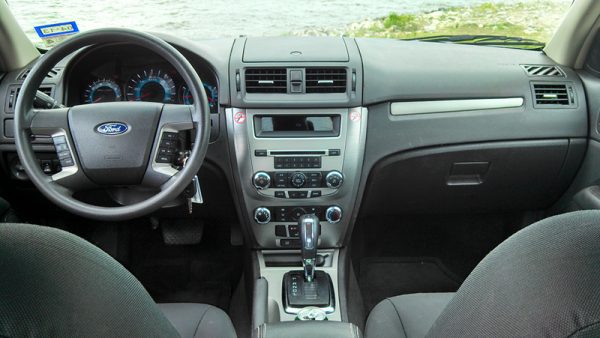

The first thing to note about the Fusion is its exterior styling: very conservative all the way around. Those built without the optional fog lights will have an ugly plastic filler on the lower front bumper cover which is a pet peeve of mine on all new cars today. On a positive note, the 2010-12 models have a more aggressive style grille and more horizontally oriented headlight housings which I think are a good improvement. Fusion also rides on nicely styled alloy wheels with 16″ tires for the SE model, and 17″ for higher levels.
When you open the door and slide into a Fusion, you’ll notice the front seats are quite comfortable, though with average support. The standard fabric has kind of a slick feel to it and looks like it can take a lot of wear. Sliding into one for the first time felt like I had been driving this car for a long time. On the inside there’s nothing really fancy about the instrument panel; it is covered in a grainy textured plastic that is not hard and the door armrests are a softer, cheap looking plastic. There is a storage compartment above the center top of the dash, and a small slide-out tray on the left side of the dash above the headlight switch (it does come with automatic headlights). The steering wheel has radio, cruise control, and information center buttons. There’s a rectangular LCD screen in the center stack that displays climate control and radio settings, or just a clock when the radio is off. The climate control buttons are down below, at the bottom of the stack. This is one thing I don’t like about this design: the button to turn on the A/C is all the way down at the bottom. The center stack on the Fusion is truly vertical, not swept back like many newer designed cars. To turn on the A/C you’ll have to reach your finger all the way down in front of the shifter to the bottom of the stack where it meets the console. The console, with the power port, shifter, parking brake, cup holders, and armrest is comfortable for a long drive.
Overall, it is a comfortable interior with plenty of rear seat room for the family, but what it lacks is a modern style. Ford addressed this in the 2013 Fusion redesign. The Fusion’s cabin measures slightly larger than the Malibu: 100.7 cu. ft versus 97.7 cu. ft. Most of that extra size is in slightly more rear headroom and more front & rear shoulder room based on official measurements. Fusion also wins with more cargo space in the trunk: 16.5 cu. ft. compared to Malibu’s 15.1 cu. ft.
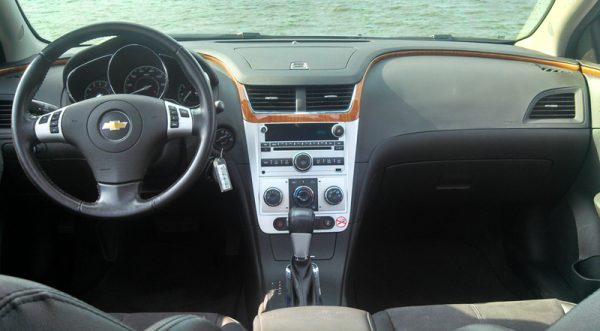
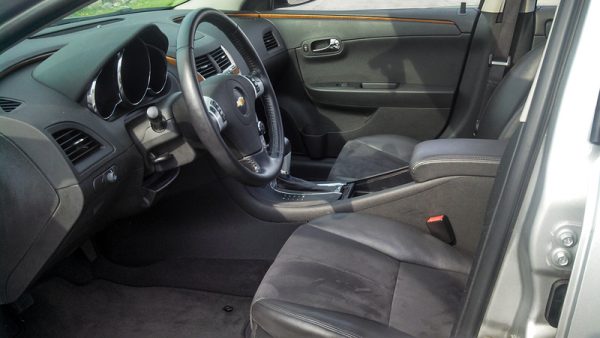
Inside, Malibu is considerably more modern than the Fusion and features a two-tier instrument panel with curves that sweep around on to the door panels, accented with a narrow wood grain trim (plastic, of course – but it doesn’t appear cheap like some previous models). There’s plenty of room for 5 passengers in this car. Standard features include all the power accessories you would expect in a modern car. In typical GM style, the windshield wiper controls are on the right side steering wheel stalk while the left (turn signal) stalk handles the headlight controls (Fusion’s headlight controls are on the dash) – it also has automatic headlights and daytime running lights. The steering wheel contains audio, cruise control, and driver information center buttons. just like the Fusion but I found the Malibu’s cruise control on-off button more intuitive to use than the Fusion’s.
Malibu gets the advantage over Fusion for its center stack design. The climate controls are not as low, so in real-world driving you don’t have to reach way down in front of the shifter to get to the A/C button. The controls are efficiently laid out, and also the LCD radio display is a more contemporary design. The console includes cupholders, storage, and power ports front and rear and they have sliding covers which helps keep things neat, although in my opinion the cupholders don’t need a cover. Both cars have a storage compartment on top of the dash above the center air vents.
The 2012 Malibu’s design features Chevrolet’s corporate-style grille up front and rear doors that appear larger than the front doors. Both cars have a rather conservative exterior style all the way around. Those built without the optional fog lights will have an ugly plastic filler on the lower front bumper cover which is a pet peeve of mine on all new cars today. On a positive note, the 2010-12 Fusion models have a more aggressive style grille and more horizontally oriented headlight housings which I think are a good improvement. Whereas the Malibu is more attractive inside, I think the Fusion definitely gets the edge for having a more attractive exterior design also rides on nicely styled alloy wheels with 16″ tires for the SE model, 17″ for higher levels.
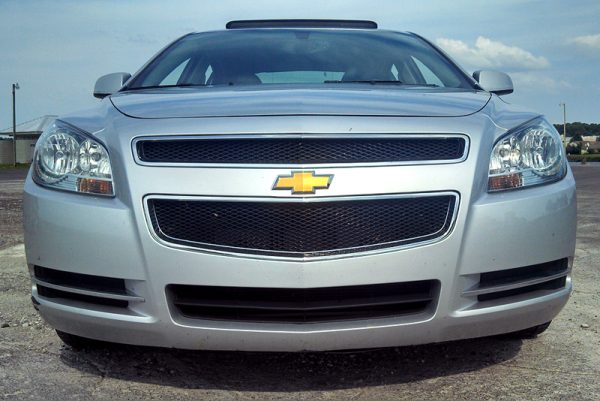

Both cars are fairly evenly matched for power. Ford’s Duratec 4 cylinder engine puts out 175hp compared to Malibu’s 169hp Ecotec engine and gas mileage is similar. I was able to achieve between 23 and 25mpg around town in real-world mixed driving. Although Fusion has slightly larger cabin, Malibu is slightly larger overall. Fusion’s length is 190 inches to Malibu’s 191.8; curb weight is 3,285lbs for the Fusion and 3,421 for the Malibu. Both engines had good acceleration for stop & go driving; putting your foot down more than a certain amount will invoke a downshift from the 6 speed automatic transaxle and both are smooth shifting. I did notice that the Fusion seemed to run a bit more rough with a little noticeable vibration at idle but the Malibu was very smooth. Both cars handled rough roads well except for the steering. Electronically-assisted power steering is becoming the norm today, replacing the age-old hydraulically assisted steering, and there is some level of disconnect in the steering wheel road feel on many cars. Malibu’s steering wheel felt somewhat vague with very light pressure. I’m not sure if the sport model is calibrated differently but in looking for a true driver’s car I would like to see a more firm, connected to the road feel in the steering wheel. Malibu rides on 17″ or 18″ wheels depending on trim level; Fusion’s base SE trim has 16″ with 17″ & 18″ wheels for all other versions. I do like the style of Fusion’s alloy wheels; they add nicely to the attractive exterior style. The models I tested were equipped with 17″ wheels.
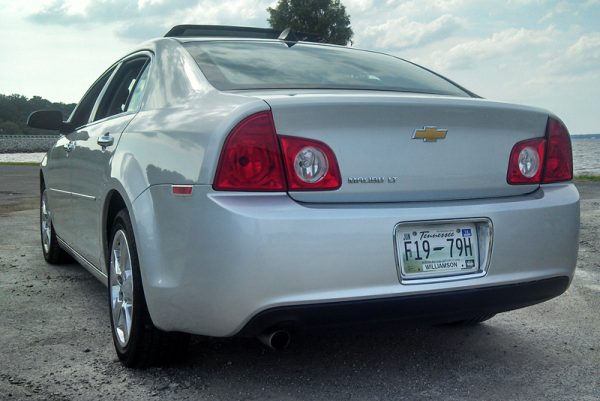

Malibu is a nice looking car, both inside and out, but the biggest disappointment to me was getting in and driving it. Specifically, the car’s ergonomics. Slide in. The seats are not quite as easy to get into as the Fusion, though they are comfortable to sit for a long drive. The seat material is what Chevrolet calls “Ultralux”, which has leather-like inserts for the bolsters and a suede-like material for the center portion of the cushion & seatback. Its not quite as “slippery” as Fusion’s standard seat. Then, close the door. Malibu’s doors open w-i-d-e. For me, at 6 feet tall with decent length arms, when the driver’s door was opened all the way I literally could not reach the armrest handle to pull it closed. I had to lean out somewhat uncomfortably. You’ll have to always be conscious of how far you open the door. Then another interesting observation. I like to drive with the window down on a nice day. With the driver’s window down there is a very significant level of wind noise and buffeting on me. While I’m not a design engineer, I think the problem has to do with aerodynamics & the design of the mirror and doors. The front doors are somewhat short: with the seat adjusted properly (not too far back) the rear edge of the door and center pillar are just inches from my head and shoulder. That stream of air is flowing across the window and smashing against the door pillar almost right next to my ear, giving me both a stiff breeze and plenty of wind noise. I did not notice this in other cars, possibly because the rearview mirror housing forced the air to go around and not across the window area. That’s just my theory, but it IS annoying. Another thing to beware of is the “A” pillar. The windshield is raked back to provide the car with good aerodynamics, but if you are making a left turn and need to see oncoming traffic your vision can be blocked by the passenger side windshield pillar. The pillars are thicker due to them containing air bags.
Granted, the redesigned 2013 model could have addressed these issues but comparing these two 2012 models, being closely matched in most other areas, I would have to give the advantage to the Ford Fusion. Despite the Malibu having a more attractive style and comfortable ride I really couldn’t see myself owning a car with such a significant wind noise issue with the window open caused by the body design. The Fusion is a better car to drive, ergonomically. It is smooth and quiet and comes with many of the same features as the Malibu and Ford created a version of the car to meet almost anyone’s needs: a good, solid player in the crowded midsized car field.
The Ford Fusion and Chevy Malibu are two competitors in the crowded field of mid-sized cars. I recently had the opportunity to review both 2012 models and am going to present a detailed real world comparison.


The 2012 Fusion is the final edition of the first generation for this car, Ford’s midsized offering positioned directly between the compact Focus and the fullsized Taurus. The Mexico-built Fusion was born for the 2006 model year as a replacement for the 1994-2005 Contour. When first introduced, the Mercury Milan and Lincoln MKZ were similar models all built on Ford’s Mazda-designed midsized car platform. Fusion comes standard with a 2.5 liter 4 cylinder engine; 3.0 liter V6 and hybrid engines are optional with the 6 speed automatic transaxle.
The 2012 Chevy Malibu is also the last edition of its generation. Unlike the original Malibu from the 1970s, Chevy introduced the modern incarnation in 1997 as a front wheel drive sedan. When this 3rdgeneration came out in 2008, the automotive press gave it critical praise for its modern design and richer feel cabin, earning several Car of the Year awards. This car rides on GM’s Epsilon platform, designed by Opel. Power choices are very comparable to the Fusion: a 2.4 liter Ecotec 4 cylinder engine is standard and a 3.6 liter V6 is optional with the 6 speed automatic transaxle. There is no hybrid version available.


The first thing to note about the Fusion is its exterior styling: very conservative all the way around. Those built without the optional fog lights will have an ugly plastic filler on the lower front bumper cover which is a pet peeve of mine on all new cars today. On a positive note, the 2010-12 models have a more aggressive style grille and more horizontally oriented headlight housings which I think are a good improvement. Fusion also rides on nicely styled alloy wheels with 16″ tires for the SE model, and 17″ for higher levels.
When you open the door and slide into a Fusion, you’ll notice the front seats are quite comfortable, though with average support. The standard fabric has kind of a slick feel to it and looks like it can take a lot of wear. Sliding into one for the first time felt like I had been driving this car for a long time. On the inside there’s nothing really fancy about the instrument panel; it is covered in a grainy textured plastic that is not hard and the door armrests are a softer, cheap looking plastic. There is a storage compartment above the center top of the dash, and a small slide-out tray on the left side of the dash above the headlight switch (it does come with automatic headlights). The steering wheel has radio, cruise control, and information center buttons. There’s a rectangular LCD screen in the center stack that displays climate control and radio settings, or just a clock when the radio is off. The climate control buttons are down below, at the bottom of the stack. This is one thing I don’t like about this design: the button to turn on the A/C is all the way down at the bottom. The center stack on the Fusion is truly vertical, not swept back like many newer designed cars. To turn on the A/C you’ll have to reach your finger all the way down in front of the shifter to the bottom of the stack where it meets the console. The console, with the power port, shifter, parking brake, cup holders, and armrest is comfortable for a long drive.
Overall, it is a comfortable interior with plenty of rear seat room for the family, but what it lacks is a modern style. Ford addressed this in the 2013 Fusion redesign. The Fusion’s cabin measures slightly larger than the Malibu: 100.7 cu. ft versus 97.7 cu. ft. Most of that extra size is in slightly more rear headroom and more front & rear shoulder room based on official measurements. Fusion also wins with more cargo space in the trunk: 16.5 cu. ft. compared to Malibu’s 15.1 cu. ft.


Inside, Malibu is considerably more modern than the Fusion and features a two-tier instrument panel with curves that sweep around on to the door panels, accented with a narrow wood grain trim (plastic, of course – but it doesn’t appear cheap like some previous models). There’s plenty of room for 5 passengers in this car. Standard features include all the power accessories you would expect in a modern car. In typical GM style, the windshield wiper controls are on the right side steering wheel stalk while the left (turn signal) stalk handles the headlight controls (Fusion’s headlight controls are on the dash) – it also has automatic headlights and daytime running lights. The steering wheel contains audio, cruise control, and driver information center buttons. just like the Fusion but I found the Malibu’s cruise control on-off button more intuitive to use than the Fusion’s.
Malibu gets the advantage over Fusion for its center stack design. The climate controls are not as low, so in real-world driving you don’t have to reach way down in front of the shifter to get to the A/C button. The controls are efficiently laid out, and also the LCD radio display is a more contemporary design. The console includes cupholders, storage, and power ports front and rear and they have sliding covers which helps keep things neat, although in my opinion the cupholders don’t need a cover. Both cars have a storage compartment on top of the dash above the center air vents.
The 2012 Malibu’s design features Chevrolet’s corporate-style grille up front and rear doors that appear larger than the front doors. Both cars have a rather conservative exterior style all the way around. Those built without the optional fog lights will have an ugly plastic filler on the lower front bumper cover which is a pet peeve of mine on all new cars today. On a positive note, the 2010-12 Fusion models have a more aggressive style grille and more horizontally oriented headlight housings which I think are a good improvement. Whereas the Malibu is more attractive inside, I think the Fusion definitely gets the edge for having a more attractive exterior design also rides on nicely styled alloy wheels with 16″ tires for the SE model, 17″ for higher levels.


Both cars are fairly evenly matched for power. Ford’s Duratec 4 cylinder engine puts out 175hp compared to Malibu’s 169hp Ecotec engine and gas mileage is similar. I was able to achieve between 23 and 25mpg around town in real-world mixed driving. Although Fusion has slightly larger cabin, Malibu is slightly larger overall. Fusion’s length is 190 inches to Malibu’s 191.8; curb weight is 3,285lbs for the Fusion and 3,421 for the Malibu. Both engines had good acceleration for stop & go driving; putting your foot down more than a certain amount will invoke a downshift from the 6 speed automatic transaxle and both are smooth shifting. I did notice that the Fusion seemed to run a bit more rough with a little noticeable vibration at idle but the Malibu was very smooth. Both cars handled rough roads well except for the steering. Electronically-assisted power steering is becoming the norm today, replacing the age-old hydraulically assisted steering, and there is some level of disconnect in the steering wheel road feel on many cars. Malibu’s steering wheel felt somewhat vague with very light pressure. I’m not sure if the sport model is calibrated differently but in looking for a true driver’s car I would like to see a more firm, connected to the road feel in the steering wheel. Malibu rides on 17″ or 18″ wheels depending on trim level; Fusion’s base SE trim has 16″ with 17″ & 18″ wheels for all other versions. I do like the style of Fusion’s alloy wheels; they add nicely to the attractive exterior style. The models I tested were equipped with 17″ wheels.


Malibu is a nice looking car, both inside and out, but the biggest disappointment to me was getting in and driving it. Specifically, the car’s ergonomics. Slide in. The seats are not quite as easy to get into as the Fusion, though they are comfortable to sit for a long drive. The seat material is what Chevrolet calls “Ultralux”, which has leather-like inserts for the bolsters and a suede-like material for the center portion of the cushion & seatback. Its not quite as “slippery” as Fusion’s standard seat. Then, close the door. Malibu’s doors open w-i-d-e. For me, at 6 feet tall with decent length arms, when the driver’s door was opened all the way I literally could not reach the armrest handle to pull it closed. I had to lean out somewhat uncomfortably. You’ll have to always be conscious of how far you open the door. Then another interesting observation. I like to drive with the window down on a nice day. With the driver’s window down there is a very significant level of wind noise and buffeting on me. While I’m not a design engineer, I think the problem has to do with aerodynamics & the design of the mirror and doors. The front doors are somewhat short: with the seat adjusted properly (not too far back) the rear edge of the door and center pillar are just inches from my head and shoulder. That stream of air is flowing across the window and smashing against the door pillar almost right next to my ear, giving me both a stiff breeze and plenty of wind noise. I did not notice this in other cars, possibly because the rearview mirror housing forced the air to go around and not across the window area. That’s just my theory, but it IS annoying. Another thing to beware of is the “A” pillar. The windshield is raked back to provide the car with good aerodynamics, but if you are making a left turn and need to see oncoming traffic your vision can be blocked by the passenger side windshield pillar. The pillars are thicker due to them containing air bags.
Granted, the redesigned 2013 model could have addressed these issues but comparing these two 2012 models, being closely matched in most other areas, I would have to give the advantage to the Ford Fusion. Despite the Malibu having a more attractive style and comfortable ride I really couldn’t see myself owning a car with such a significant wind noise issue with the window open caused by the body design. The Fusion is a better car to drive, ergonomically. It is smooth and quiet and comes with many of the same features as the Malibu and Ford created a version of the car to meet almost anyone’s needs: a good, solid player in the crowded midsized car field.
